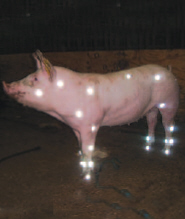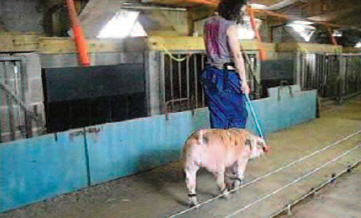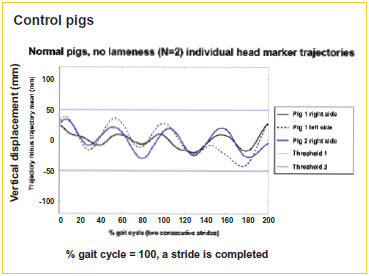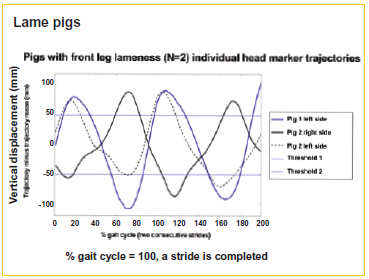



Predicting Leg Soundness through Biomechanical Assessment of Gait in Pigs
Research findings from a BPEX-funded PhD project carried out at Newcastle University investigating the potential of biomechanical techniques to predict leg soundness in pigs since lameness is a major cause of lost productivity for the pig industry, published by BPEX as No.24 in its 'Research into Action' series.
The aim of the project was to develop objective methods of assessing locomotion in pigs which could help to identify those pigs likely to develop a foot or a leg problem later in life, because of their conformation or structural development, at a relatively early stage.
Infrared camera-based motion capture was applied to three different cohorts of pigs in three experiments, including an observational study following 84 gilts from grower to second parity stage.
Experiment 1
A longitudinal treatment study which evaluated the impact of three different pen floors (deep straw-bedded, fully slatted and partly-slatted) on the gait characteristics of groups of eight pigs housed on each floor for a duration of 11 weeks.
Experiment 2
A study assessing the repeatability of the methodology on three pigs, each pig giving 10 repeated measurements over a duration of five days.
Experiment 3
A long-term observational study with repeated application of motion capture of 84 female breeding pigs over 1.5 years. Early (subclinical) and clinical gait characteristics of pigs with lameness were compared to control pigs without lameness.

The hope is that detecting subclinical abnormalities and automating lameness detection could improve the ability of breeders and producers to indirectly select for longevity, both in nucleus and in replacement animals. It could also facilitate the early treatment of locomotion problems before there is a progression in severity and ideally such problems could be prevented.
Findings
The results from this research indicate that gait analysis does offer potential for automated prediction and early detection of lameness, pending the development of adequate software and simplification of the process.
The following observations were made:
- Measured changes in gait patterns over time were largely unaffected by the floor surface on which growing and finishing pigs were reared
- Detecting true gait deviation using marker-based kinematic methodology may require repeated marker placements for anatomical regions known to promote marker misplacement, e.g. proximal hind limb
- Gait measurements with low repeatability between marker placements, e.g. absolute joint flexion, should be interpreted with caution (Figure 1).
- Joint flexion within marker placement shows a good within/between pig variability relationship and could be used in the research of long-term flexion effects on orthopaedic health.

Temporo-spatial gait parameters, such as head movement and asymmetry indices, reliably detected lameness (Figure 3), however, more intuitive lameness indicators, such as short stride lengths and reduced stance times, were not consistently measured in lame pigs.
The step-to-stride length ratio could detect up to 75 per cent of the pigs which subsequently developed lameness
Elbow joint flexion during walking significantly increased in finishing pigs and this was not observed in pre-breeding gilts at equivalent growth stages
There are likely to be mobility differences in finishing and growing breeding pigs which require further evaluation with respect to lameness, welfare, diets and genetics.


Conclusions
This study identified kinematic gait parameters sensitive to lameness in pigs. Although the number of lame pigs was relatively low, there were consistent and substantial changes in affected pigs.
Biomechanical evaluation of pigs is still a very complex process that requires some simplification before it could be used at farm level. For an automated gait analysis approach, adequate software needs to be developed first and before the automated use of any of the currently identified sensitive gait parameters, a customised software algorithm for pigs is required.
However, gait analysis does offer potential for the future automated prediction and early detection of lameness and for the purposes of selecting replacement breeding animals, gait measurements may be more successful than subjective classification in targeting longevity characteristics of pigs and preventing lameness.
November 2014








